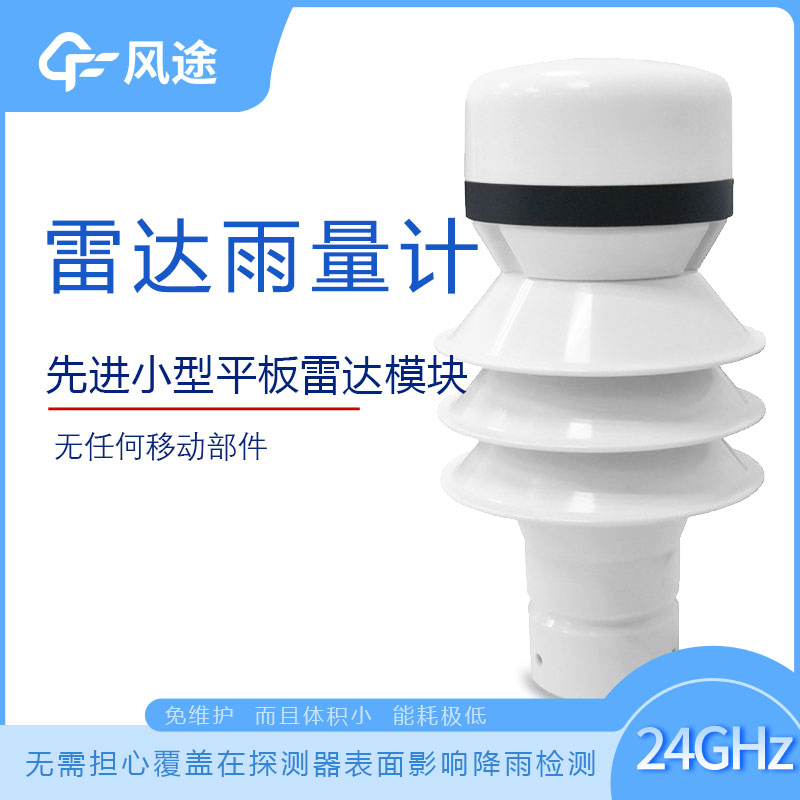Shandong Fengtu IOT Technology Co., Ltd
Sales Manager:Ms. Emily Wang
Cel,Whatsapp,Wechat:+86 15898932201
Email:info@fengtutec.com
Add:No. 155 Optoelectronic Industry Accelerator, Gaoxin District, Weifang, Shandong, China

Sales Manager:Ms. Emily Wang
Cel,Whatsapp,Wechat:+86 15898932201
Email:info@fengtutec.com
Add:No. 155 Optoelectronic Industry Accelerator, Gaoxin District, Weifang, Shandong, China
time:2023-08-15 17:42:47 source:Weather Station viewed:782 time
Among radar rain gauges, the YL4 Radar Rain Gauge utilizes an advanced small flat panel radar module and 24 GHz Doppler radar wave technology to measure the rate of droplet descent during the rainfall process and to differentiate the type and intensity of rain, snow, and hail based on droplet size and descent rate.The YL4 Radar Rain Detector is much more sensitive and quicker to detect the beginning and end of the rainfall than the traditional mechanical rainfall detection methods. The YL4 radar rainfall detector is more sensitive and quicker than traditional mechanical rainfall detection methods to detect the beginning and end of rainfall without the worry of leaves and other objects covering the surface of the detector and without the need to set up a heating device to prevent freezing.The YL4 detector has no moving parts, is virtually maintenance-free, and is small in size and consumes very little energy.
Rainfall information, as a primary objective of atmospheric and precipitation research measurements, is an important indicator parameter in environmental monitoring and agricultural safety monitoring. Usually we monitor rainfall, commonly used bucket type, optical rain gauge and radar rain gauge to the natural world rainfall perception, and on this basis into the corresponding switching signal output, can meet the majority of the scene under the information transmission, processing, recording, display and other needs.
Precipitation monitoring is to observe the precipitation amount and intensity in time and space. Measurement methods mainly include the use of rain gauges for direct measurement and the use of weather radar, satellite cloud charts for precipitation estimation and other indirect means. The direct observation method requires the establishment of a rainfall station network, station network deployment must have a certain spatial density, specified uniform frequency, transfer of data time, etc., the relevant requirements depending on the expectations of the use of the situation.
Tipping bucket rain gauge the method is relatively single function, the use of mechanical equipment to measure rainfall, although rainfall data can be obtained, but can not reflect the size of the rainfall in real time, only a certain period of time rainfall statistics. For some industries that need more than one rainfall data, its role is slightly lacking. But the introduction of radar rain gauge, but cracked the dilemma.
Translated with www.DeepL.com/Translator (free version)

rainfall sensor is a device used to detect rainfall. It integrates optical algorithms to sense rapidly changing weather and accurately detect rainfall in real time....
Duct air velocity measurement is a common operation in industrial production and environmental monitoring. Its main purpose is to monitor the flow rate of wind velocity inside a pipeline to ensure that the fluid (usually gas) inside the pipeline is within a controlled range.In industrial production,...
With the acceleration of the new industrialization process, the importance of ecological environment protection has become increasingly prominent. In the past, industrial development overlooked the cost of the natural environment to some extent. Nowadays, people deeply understand that economic devel...
In an air quality monitoring station, the "four gases" refer to sulfur dioxide (SO₂), nitrogen dioxide (NO₂), carbon monoxide (CO), and ozone (O₃), while the "two particulates" are fine particulate matter (PM2.5) and inhalable particulate matter (PM10).Cities are vast in space...